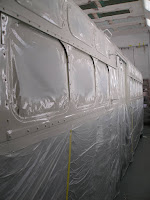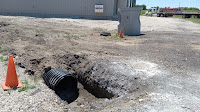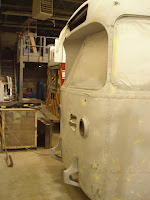Thursday, June 30, 2022
North Western Building Progress
Wednesday, June 29, 2022
Updates white as they happen
Tuesday, June 28, 2022
It's a Stretch
Monday saw some more progress on the 460 roof project.
To start with, I tightened up the clamps that were already attached to the canvas at both ends, added a few more, and then installed two on either side at the middle.
Monday, June 27, 2022
Going Green
Friday, June 24, 2022
Washday Chores
Thursday, June 23, 2022
Chicago Heights Street Railway
Wednesday, June 22, 2022
Trolley Bus Update
Tuesday, June 21, 2022
Muggy Monday
Meanwhile, we see that the 306's roof is completely painted, and saddles can be installed soon. John is working on tracing out the motor circuits, among other things, and Fred was working on the trolley bases.
Monday, June 20, 2022
In Memoriam John Faulhaber
We regret to report the death of John Faulhaber, who was for many years a faithful member of the Car Department crew. He was a friendly, hardworking, and valuable member of the Museum, liked by everybody who knew him. He will certainly be missed.
Funeral arrangements in his home town of Genoa will be this Thursday, June 23, and details can be found at this link:
John Faulhaber Obituary (1941 - 2022) - Genoa, IL - Chicago Tribune (cleveland.com)
Sunday Progress
So a good portion of my afternoon was taken up with an inspection of the 18's running gear, to identify any other issues that might affect our plans to put the car into public operation at some point. A couple of minor things were found, but nothing significant (nor particularly expensive to fix). So after that, I spent some time needle-chipping the paint off of the front corner post and front bumper, with the results shown above.
After dinner, Greg did some electrical testing on the marker light circuit, and confirmed Zach's suspicions from last year that the failure of the markers to light is due to a bad resistor. He removed the above assembly, which is pretty much just a tin can with the resistor inside of it that sits underneath the rear bench seat inside the car. We will need to try and figure out the value of this resistor and then order a new one, after which - hopefully - the rear markers will light.
Speaking of dinner, it was a very nice outdoor BBQ at the Central Avenue Pavilion in honor of Marcus' birthday. A good crowd of volunteers turned out, as shown here. Happy birthday, Marcus!
I pointed out to Joel that it was foolish to walk the long distance from the car shop to Central Avenue when we could take public transit instead, so he relented and a group of us took the 18 over to dinner instead. Nick, shown here, spent a while expounding upon the car's historic significance to our collection. Nathan and Mikey are in the cab.
And finally, though rewinding a bit, earlier in the day I again stopped by the bus barn on my way in. Richard and Jerry were back working on cleaning out and stabilizing the CTA articulated trolley bus. It hadn't really moved laterally since Saturday, but they had aired up the tires, so I guess it moved upwards slightly. In case you were curious, this is a pretty weird articulated because the articulation joint only moves vertically - the front and rear sections don't turn side-to-side at all, and both the front and rear axles "steer." It's definitely an oddball!






















































